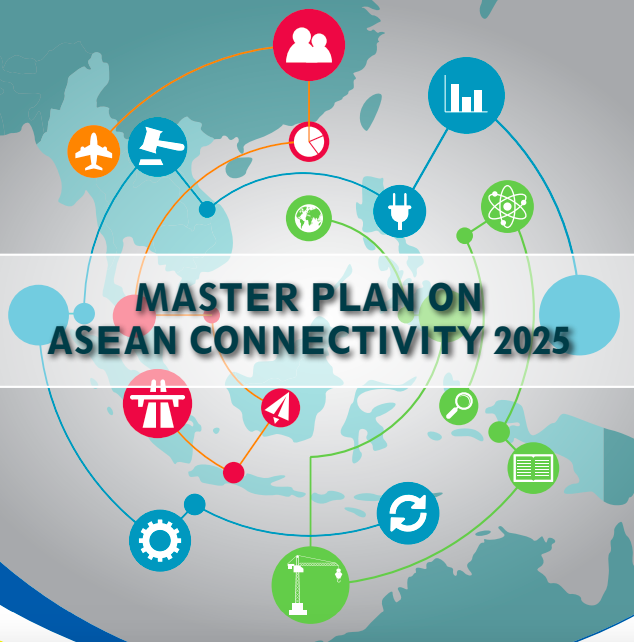
It has now been a little more than two years since the ASEAN Master Plan on Connectivity 2025 was introduced. It seemed that, following years of calls for increased investment, ASEAN as an organization has recognized the need for regional infrastructure to enable closer economic and social linkages between the member states. The current plan, an update over the 2011 version, has a firm footing in global connectivity trends and a more focused agenda. Compared to the first plan, which had a bit of a wish-list character, the current connectivity plan has been well-received, particularly by ASEAN’s external partners.
But in spite of this, ASEAN has found it increasingly difficult to perpetuate its regional connectivity vision in the face of competing strategies by external partners. Since the launch of the first Connectivity Master Plan in 2011, there has been a flurry of connectivity meetings, forums, strategic plans and commitments, by a variety of dialogue partners and international organizations. The most significant of these are clearly the Chinese Belt and Road Initiative as well as Japanese connectivity support to the region under various guises, most recently under the umbrella of the Free and Open Indo-Pacific Strategy. Activities by the Republic of Korea, the United States, Australia, India, and the European Union contribute to what increasingly appears to be a new geoeconomic battlefield.
What is so special about these external partner conflicts regarding the future of the region? After all, Southeast Asia has always been at the center of great power rivalries. The key difference in connectivity compared to the political and security sector is that there is less slack for national governments to deviate from the regional strategy to pursue purely self-interested goals without jeopardizing the regional strategy. Connectivity, in principle, can only be attained if countries act in tandem. A road built to nowhere will not contribute to better trade or travel between two countries. The opportunity costs of misguided connectivity implementation at the national level result in larger regional repercussions than in other policy areas.
The different quality of connectivity governance is highlighting how persistent difficulties to create regional-national coherence within ASEAN are jeopardizing the execution of regional strategies. The lack of regional-national coherence within ASEAN creates a challenge for the organization at two fronts: 1. Regionally, through the contestation of the ASEAN regional connectivity vision by external partners, and 2. Nationally, through the implementation of competitive rather than complementary connectivity projects by external partners. Resolving these two pressure points will require ASEAN to back up its regional connectivity vision with effective regional governance mechanisms.
How did the two pressure points emerge? The heart of the matter is how ASEAN governs regional connectivity: The organization has created the Connectivity Coordination Council tasked with supervising the connectivity agenda, which is being assisted by the Connectivity Division within the ASEAN Secretariat. While the intergovernmental council consists of the same member state representatives that supervise all decision-making in Jakarta, the Connectivity Division has been endowed with an unprecedented mandate to prepare projects, engage with partners and facilitate integration of the connectivity agenda throughout ASEAN’s innumerable sectoral bodies.
But regardless of the governance innovations in connectivity, ASEAN remains path-dependent. It is up to the sectoral bodies to address the issues of the connectivity agenda in their respective meetings. The sectoral bodies are groups of government experts, which are tasked with agreeing on regional priorities in specific policy areas, such as logistics, infrastructure, or customs, meeting once or twice a year. These bodies are at the forefront of ASEAN decision-making and are the key actors tasked with addressing the objectives of all ASEAN strategic plans. They are not accountable to anyone apart from their national executives and decide on their own activities and reporting procedures. Despite ambitions to spread connectivity priorities throughout ASEAN, there is scant evidence that the connectivity agenda has been taken up by these bodies as a priority. The consequences of this is the first pressure point: Weak execution of the connectivity master plan empowers alternative plans by other external partner, which execute their connectivity visions more coherently.
Furthermore, it is unclear to which degree the regional connectivity agenda has been taken up by ASEAN’s governments. Despite rhetorical commitments made to regional connectivity by heads of state, most recently by the incoming Thai ASEAN Chair, ASEAN countries are mainly going at it alone. This is due to the source of funds for connectivity projects. Despite the setting up of the ASEAN Infrastructure Fund with the Asian Development Bank in 2011, most connectivity-related projects are funded either by international financial institutions, national development banks, or by national governments such as China and Japan and their development agencies or other financing schemes. This is to be expected given the daunting costs of Asian infrastructure needs, which could hardly be borne by any single actor.
But many national-level projects are jeopardizing regional connectivity progress. Belt and Road Initiative projects are not always contributing to ASEAN connectivity, often being more linked with Chinese value chains, development objectives, institutions and companies. Projects like the port of Kyaukpyu, Myanmar, or Koh Kong, Cambodia, are not obviously improving regional connectivity, lacking profitability and transparency and are otherwise notable for a strong presence of the Chinese Communist Party on the ground. The Melaka Gateway harbor in Malaysia is also distinguished by its unprofitability but is also a clear countermove against Singapore’s successful shipping infrastructure. These issues extend beyond port projects. Investment in Lao hydropower projects is creating negative externalities in the other Mekong states. The problem is not limited to China. Japan, while generally seen as more in line with the regional connectivity vision, is also openly pursuing linkages supportive of Japanese firms and interests. Similar arguments can be made for other states involved in connectivity financing, such as the EU or the US. This is the second pressure point that ASEAN is facing in executing its connectivity agenda.
ASEAN appears to deal with these competing interests like it has in the past: By hedging against unilateral exertion of power by one single actor. Recent moves by the EU and the US to engage more deeply in the financing of infrastructure and other connectivity projects will be welcomed by ASEAN member states because they make it easier to execute a hedging strategy. But this will only provide a temporary solution to ASEAN’s connectivity challenges. In the long run, ASEAN states must be able to coherently articulate their connectivity strategy not just at regional summits, but also in their national development strategies as well as in their relations with individual partners.
In the ideal case, ASEAN member states should reject connectivity projects that promote alternative visions of connectivity (whether they be Chinese, Japanese, or European) at the expense of ASEAN’s connectivity vision. But this is unlikely. Most ASEAN states are under intense pressure to deliver national development and bridge infrastructure gaps as quickly as possible. There appears to be no national policy space for lofty regional goals at this point. That’s why regional governance mechanisms must be empowered even further to ensure that the regional connectivity vision remains front and center. International financial institutions may help in doing this; the World Bank, for example, is already engaged with the Connectivity Division. But more ASEAN-led coordination is needed. For starters, the ASEAN Infrastructure Fund, to which US$450 million had been committed in 2011, should be used more, beyond the ten projects that have been financed since its inception.
The hard truth is that regardless of partner declarations, nobody will ever care as much about ASEAN connectivity as ASEAN states themselves. It is therefore up to ASEAN member states to ensure the success of the connectivity master plan and set the stage for a successful connectivity within the region.

Lukas Maximilian Müller is a PhD researcher at the University of Freiburg, Germany. He mainly works on regionalism in the Global South, with a focus on the policy contributions of distinctive regional institutions. His main research project concerns the contributions of the ASEAN Secretariat to Southeast Asian regionalism. He has published on EU-ASEAN Interregionalism as well as ASEAN Connectivity. Lukas also works as a researcher for the Asia-Europe Foundation, focusing on the mainstreaming of the Sustainable Development Goals in Southeast Asian developing countries.
